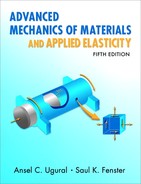Footnotes
* Historical reviews of mechanics of materials and the theory of elasticity are given in Refs. 1.1 through 1.5.
* Further discussion of uniaxial compression stress is found in Section 11.6, where we take up the classification of columns.
* In this case, the body is not in static equilibrium, and the inertia force terms –ρax, –ρay, and –ρaz (where ax, ay, and az are the components of acceleration) must be included in the body force components Fx, Fy, and Fz, respectively, in Eqs. (1.14).
* More details and illustrations of these assumptions are given in Chapter 3.
* After Otto Mohr (1835–1918), professor at Dresden Polytechnic. For further details, see Ref. 1.7, for example.
* For a detailed discussion of the elastic properties of various classes of materials, see, for example, Refs. 2.1 and 2.11.
* See, for example, Refs. 2.13 and 2.14.
* See, for example, Refs. 3.8 through 3.14.
* A summary and complete list of publications dealing with contact stress problems are given by Refs. 3.13 through 3.19.
* For further details, see Ref. 4.1 and texts on material science, for example, Refs. 4.2 through 4.4.
* From Ref. 4.14. For further details related to failure criteria for metal fatigue, see Refs. 4.8 and 4.15 through 4.17.
* For a detailed discussion, see Ref. 5.3.
* For an extensive discussion of springs, see Refs. 6.5 and 6.6.
* For a general function ![]() , defined in area coordinates, the integral of f over any triangular area A is given by
, defined in area coordinates, the integral of f over any triangular area A is given by![]()
where α, β, γ are constants.
* Refer, for example, to Ref. 8.2.
* For a detailed presentation of a number of practical problems, see Refs. 9.1 through 9.3.
* For a more rigorous mathematical treatment and an extensive exposition of energy methods, see Refs. 10.1 through 10.8.
* The range of Le/r depends on the material under consideration. In the case of structural steel, for example, long columns are those for which about Le/r > 100; for intermediate columns, 30 < Le/r < 100, and for short struts, Le/r < 30.
* The specifications of the AISC are given in Ref. 11.5. Similar formulas are available for aluminum and timber columns; see, for example, Ref. 11.6.
* For a complete discussion of this subject, see Refs. 11.7 through 11.10.
* For a detailed discussion of problems in plasticity, see Refs. 12.1 through 12.3.
* This approach was introduced by Navier in 1820. For details, see Refs. 13.1 and 13.2.
